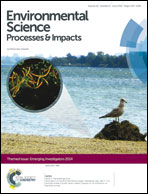Ecological and enzymatic responses to petroleum contamination
Abstract
The changes in microbial ecology interpreted from taxonomic and functional genes and biological functions represented by urease and dehydrogenase activities were monitored in soil contaminated with different petroleum hydrocarbons including crude oil, diesel, n-hexadecane and poly-aromatic hydrocarbons (PAHs). It was shown that the presence of n-hexadecane stimulated the activity of indigenous microorganisms, especially alkane degrading bacteria, and led to over 20% degradation of n-hexadecane within one month. No obvious degradation of the other three types of petroleum hydrocarbons was observed. The stimulation effect was most marked in the soil spiked with a medium concentration (2500 mg kg−1 dry soil) of n-hexadecane. However, the presence of PAHs completely inhibited the previously-mentioned bioactivities of the soil. The content of PAH degrading bacteria, however, increased more than 10-fold, indicating the selection effect of PAHs on soil bacteria. The impacts of diesel and crude oil on the microbial ecology and biological functions varied significantly with their concentration. The disclosure of the ecological and enzymatic responses could be helpful in soil bioremediation.


 Please wait while we load your content...
Please wait while we load your content...